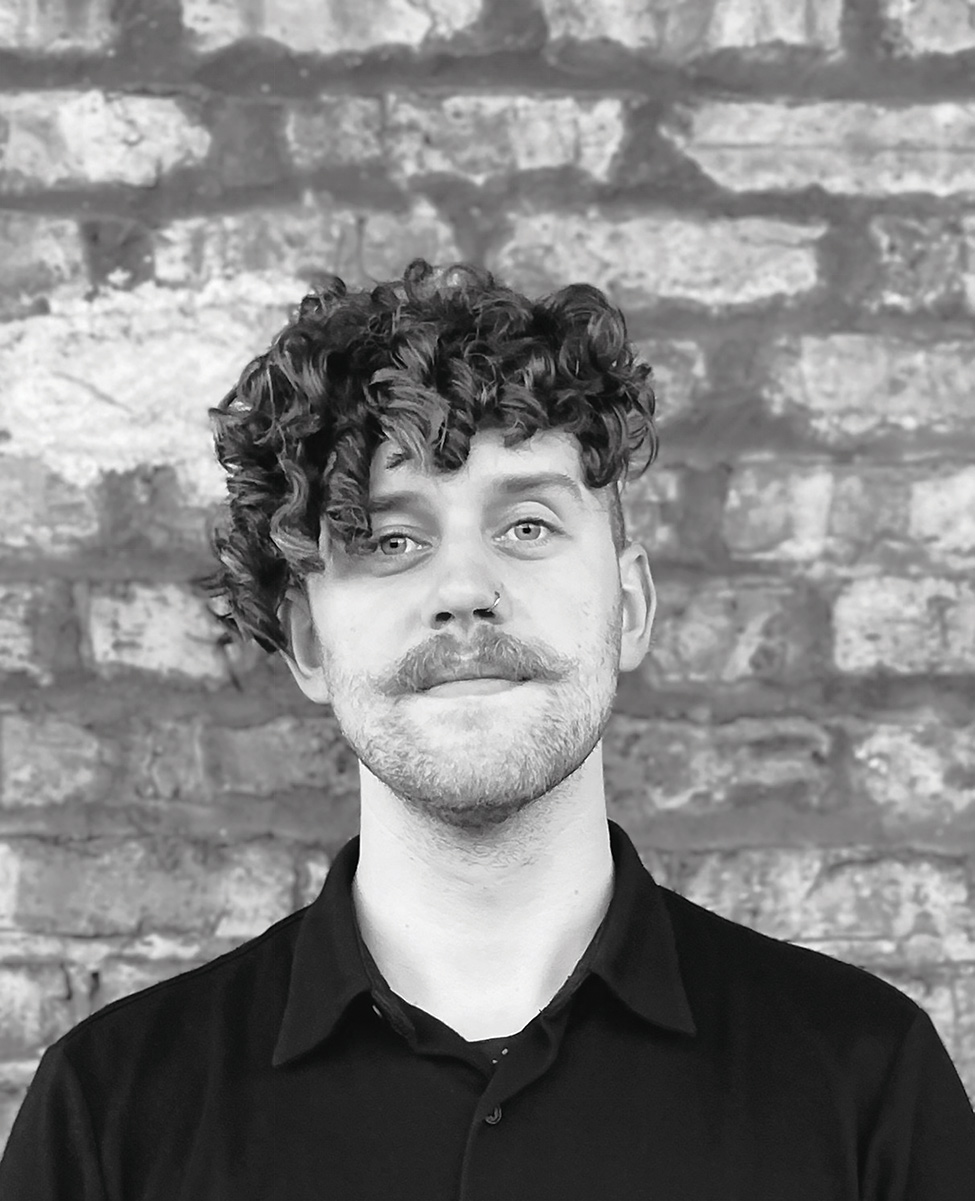Richard Hull: Chicago's Lasting Impression on an Artist

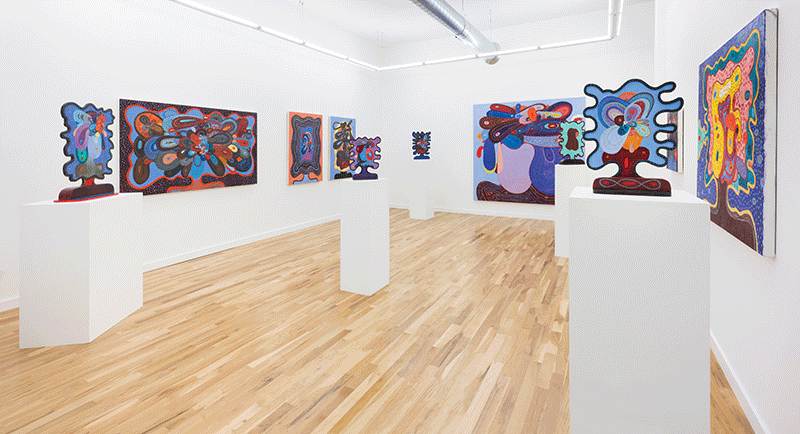
By GINNY VAN ALYEA
Richard Hull is not from Chicago, but his art distinctly is.
Encouraged by a professor while attending the Kansas City Art Institute in the 1970s, he moved to Chicago in 1978 to study for his MFA at the School of the Art Institute. First drawn to the Imagists, a Chicago-based group of artists that had been active more than a decade before his arrival, Hull found his own niche quickly and enjoyed a string of good professional and artistic fortune before he even graduated from SAIC.
Many artists have come to the city on their way elsewhere, but Hull stayed. “I’ve been here over 40 years now,” he says on a sunny afternoon seated in his new West Town studio. Asked what has kept him here for four decades, instead of just one, he explains, “I wasn’t going to come here but my teacher convinced me I had to. One of the reasons I stayed was because so many good things happened quickly for me, while I was still in school. Within one year I was busy selling paintings and showing with Phyllis Kind [Gallery]. I was not planning for anything like that.”
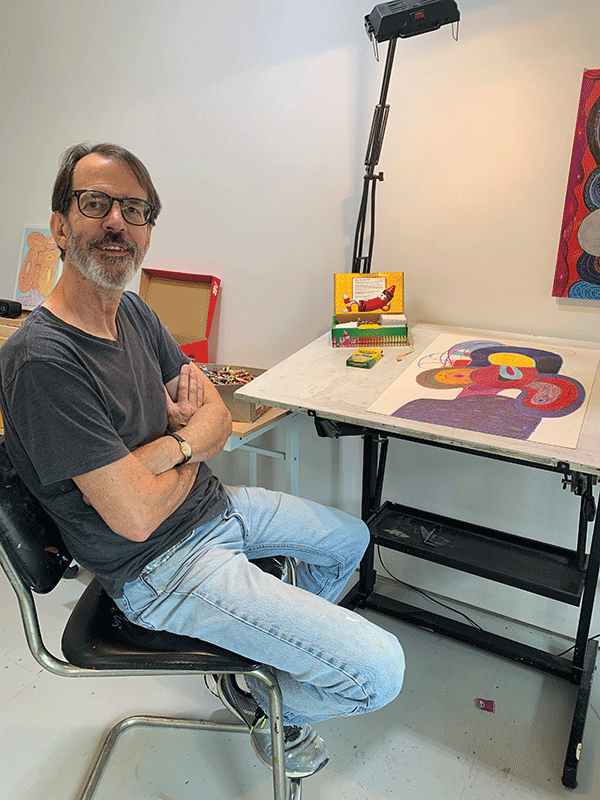
Hull considers himself fortunate that life was easy enough to keep afloat. At the time, “Things were going well, and it was kind of easy where I was living. It was cheap.” But there were other determining factors: the high-profile art dealer Phyllis Kind, who had a presence in Chicago as well as New York, admired the young artist’s work. Her art world connections led to interactions with people in other disciplines in Chicago, such as theater. Exposure to a broader cultural world of musicians, actors and writers nurtured something in Hull, and he was inspired. “It just sort of helped me,” Hull recalls, “You know, the art world is small here. You could get really ground down by it. I had access to a lot of other people and ideas.
Hull almost ventured to New York in the early ‘80s, at Kind’s behest, since he was exhibiting as much there as he was in Chicago, but it was a dream never realized. “She thought it’d be good if I moved there, and I really thought about it for a while, but it just kind of slipped away. That’s what happens.”
Hull’s artistic life could have advanced anywhere. “It’s funny,” he says, “I’ve been here a long time, so people think I really love Chicago, and there are things I do like, but I’m not in love with Chicago.”
The art world can be its own strange universe, says Hull. “I don’t have any real complaints about Chicago, except the weather, maybe, but any complaints about the art world I won’t get into – it can be idiotic. But just leave if you really don’t like it, right?”
When I ask if many of Hull’s peers in the ‘80s left for New York, he admits that a lot of people did, but certainly not everyone. Now he suspects that many artists hang around Chicago a few years longer before moving to New York. “Chicago is a lot easier. New York is hard now. Really hard. It wasn’t so hard before.”
When asked by his own students, decades later, what’s the right move after graduate school, Hull says he would tell them, “Get all your shit, put it in your car and move to New York. Just go.” But he admits now he has reservations when giving such advice. “I really don’t like people leaving. I want to be around good people here, but the opportunity can be much greater there.”
He confesses, “I even still think about leaving. Just because.”
–

It didn’t take 40 years for Chicago to make an impression on Hull. While in Kansas City, Hull says he was heavily influenced by west coast, Bay Area funk artists, such as William Wiley, Roy De Forest, Robert Hudson and others teaching at [University of California] Davis, but when considering graduate school, he ultimately chose Chicago, largely because of the Hairy Who, a group of artists that had held a series of exhibitions while at SAIC in the 1960s, more than a decade before Hull arrived in 1978.
“I didn’t know much about the Imagists,” Hull says, “What I’d seen, I liked, but it wasn’t as if I felt like I was going to be overwhelmingly influenced when I came to Chicago. I enjoyed the artwork, but I thought it was very different from mine. That was one of the draws – I respected the work a lot, but I didn’t feel the influence.”
The colorful effects of the art produced by the Imagists did not fade; once Hull was in Chicago, he ended up exhibiting alongside members of the Hairy Who right away and reconsidering his own approach to painting.
“I wasn’t trying to be like them,” says Hull, “But then after showing with them, and even owning some works, walking by a Karl Wirsum everyday will make you think differently about shapes and images. Jim Nutt, Gladys Nilsson, Miyoko Ito – it sort of infiltrates your thinking.”
Hull’s earliest work follows a linear, architectural structure, but the Imagist reverence for form, shape and color is unmistakeable now. There is three dimensionality even in Hull’s 2-D works. With so much time between his years alongside his Hairy Who peers and now, Hull says he thinks his work, particularly the pieces focused on loops that resemble expanding water balloons, is the most like the Imagists it’s ever been.
Even though Hull got on with the Imagists quickly, he says he had a lot to learn technically, as well as aesthetically. He recalls, “When I was first showing things, I sold a work of art to someone, and I thought I was being really careful with my paintings – like really neat, and I didn’t have any brush marks. Then somebody hung it next to a Roger Brown, and I thought, ‘Oh my God, it’s a fucking mess,’ because Roger’s work is so pristine. I realized that I was still pretty different from those guys just by that.”
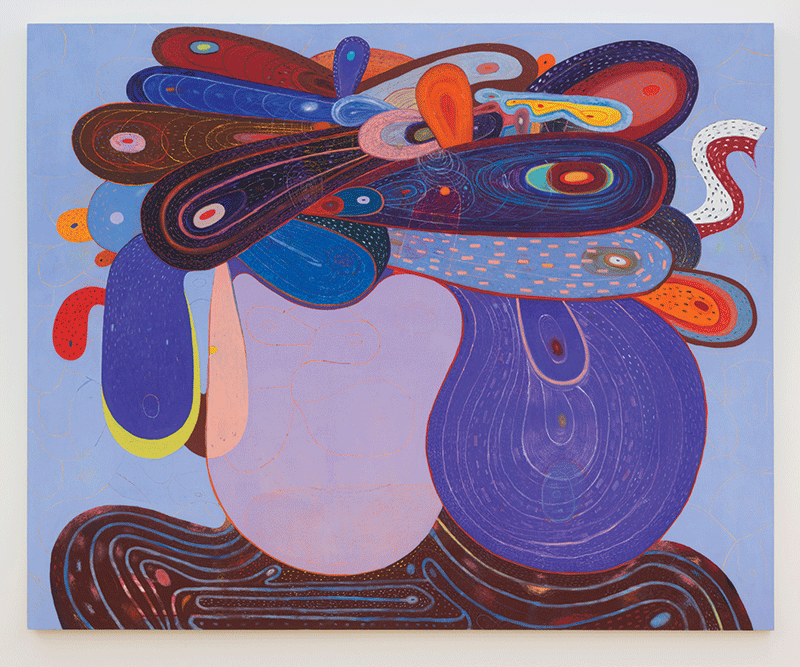
About a decade ago Hull once again referenced the Imagists when he began a series of works that call to mind abstract portraits, such as the busts depicted by Jim Nutt and Barbara Rossi. His mysterious figures, featuring facial outlines that emerge from the abstract in pieces and sometimes in profile, were a refutation of his reputation as an abstract painter. “People think that I’m an abstract painter and I don’t think I’m abstract in any way, if you think about the way paintings are made,” explains Hull. To him, there are also elements that are undeniably real.
“I wrote a statement once (I hardly do it),” he says, “I just said, everything in these paintings is real – the paint, the materials, the shapes. They’re all real things.”
Hull’s figures, while not realistic, are recognizable and deliberate. “It has to make sense to me,” he explains, “for the placement of shapes or where things go in terms of the way a head would be, or the way things are in the world, rather than just on a flat surface. I was moving towards a totally unrepresentative moment, and I wanted to pull back from that.”
Building on the head paintings and drawings from a decade ago, 3-D structures continue to evolve as Hull has begun to explore sculptures and shapes in space.
“I started those because I was doing the head shapes, and I was making a sort of a frame for them inside the painting. I think of them like mirrors, and I was having trouble every time I got to the end of the painting, so I would just leave the edges empty because I wanted to deal with the middle parts, the forms, and it would take me forever to get the right color and whatever activity would be happening around it, and I thought, ‘This is a pain in the ass. Maybe I should get rid of that.’ So I just cut the edges off the paintings.”
Now Hull collaborates with a former student to put a drawing on medium-density fibreboard (MDF) in any shape he wants, and the cut off edges are no longer a creative end point.
–
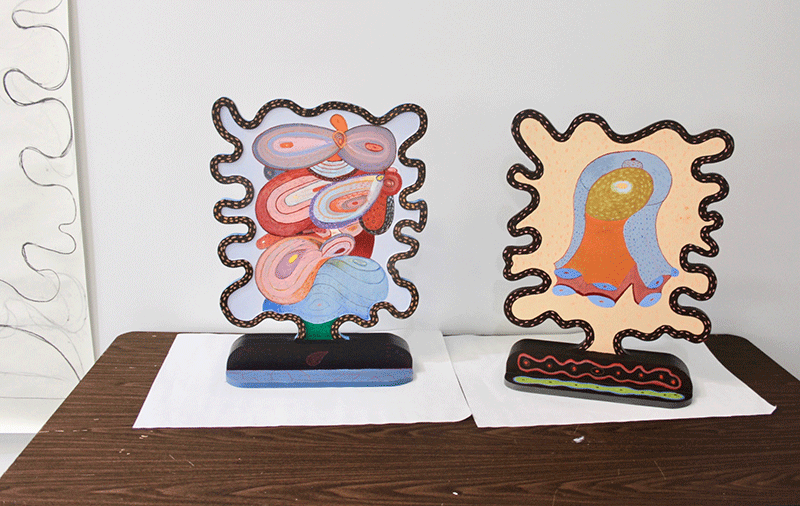
Color is a consistently dominant element in Hull’s work, one that he persistently examines and adjusts. “My only color theory is you decide on a color to start with, and then you find a color that makes that better. It’s about the relationship to the color within the piece. If I add a violet next to a red, does that make the red better or does it distract from or make the red look bad? It’s color, next color. Color, next color. And I’m always kind of surprised how colorful my things are, because I never thought of myself as a very good colorist.”
The colors in Hull’s paintings must have a mutually beneficial relationship, and the shapes, appearing over and over, layer upon layer, used in his work must be part of a harmonious composition. “It’s a kind of rhythm, really. And rhythms get interrupted. It might be my interest in music – that’s just a maybe. I don’t think, ‘Oh, I’m making musical paintings.’ It’d be idiotic. No, you just get started on it, and it feels right.”
Together these colorful figures, formed from repeating shapes, resemble elaborate, retro hairdos methodically constructed in a way that holds them together as well as presents a pleasing arrangement. Vibrant depictions of individual efforts to layer and shape transform the everyday into something remarkable.
“I was thinking of them as hairdos more than anything really,” Hull notes, though he says it’s funny, because he’s definitely not all that fascinated with hair.
–
When I ask Hull what he is working on now, he points to a handful of works in progress, placed around the studio. He’s taken a break for a few weeks, as his new space has been built out, and now, in a suitably light, fresh workspace, he’s tinkering with some crayon drawings as well as finessing some underpainting, which he says he’d never done until a couple of years ago. “I put the colors under it on the canvas and then I paint color on top of it,” he explains. “It’s really gives another kind of vibrancy to the painting, and it’s related to the crayon drawing, where I put color down and it will scratch through.”
Hull has used a variation of the technique going back to his older paintings, but it can be tedious. “I kind of hate doing it,” he admits, “because I’d rather be making the painting, not preparing the thing. But I haven’t been disciplined in doing that. Here [pointing to a work on the floor] if you get up close, you can see how the color comes through. So these are the things I’m working on now.”
Though Hull says he has not been disciplined in the preparation of individual paintings, he is methodical in his experimentation overall. He says he’s considering creating more sculptures like the ones that were part of his 2018 exhibition, perhaps working on a much larger scale, though that could mean a piece that measures eight feet tall might weigh 150 lbs. Hull suspects it would just be too much, but it’s in the back of his mind.
To get ready to install a solo booth with art dealer Scott Speh and his gallery, Western Exhibitions, at EXPO CHICAGO in September, Hull has been considering the various works he will exhibit, including many from the mid 1990s, juxtaposed with a few newer works, such as the crayon drawings. Despite having had a very busy year – his most recent show was at Western Exhibitions in April 2018, and he moved his home and his studio in 2019 – Hull emphasizes that, no matter what is going on, he is never one to turn down an opportunity.
“That’s the advice I give my students. They say ‘How should I go about a career?’ And I say just be ready. Don’t ever tell anybody ‘No.’ They’re going to forget about you and move on.”

Hull has been an adjunct professor of painting at the School of the Art Institute of Chicago for 15 years, typically with five graduate students every semester and around 30 undergraduates. While his students undoubtedly learn invaluable lessons from Hull if they listen, “Actually, he says, some of the good ones don’t, and they may be the best,” he emphasizes that education is a two way street.
Is his wisdom today drastically different from what he would have dispensed more than a decade ago? “I don’t know if I’ve evolved that much,” he says.
If the advice is constant, the artist is not. “Well, maybe I’ve just become more confident and able to talk now. I didn’t talk hardly at all before I started teaching. Now, I talk too much. That’s what teaching will do to you. It makes you organize your thoughts. It’s been good for me.”
Hull says SAIC is an amazing place to teach. He’s long admired how much the faculty cares about students and how they are always assessing how to be helpful and supportive. The school has come to embody an ideal role in the art world, where students and teachers try and examine what others are working on and consciously be constructive, in order to continue to all push art to the next level. “It always feels good for all of us [at SAIC] when somebody does well, and a lot of people do.”
Thinking about the professor who encouraged him to move to Chicago 40 years ago, Hull explains, “His name was Ron Slowinski. He had gone to school with [artist and mentor to the Imagists] Ray Yoshida in the ‘50s, and he was friends with [art critic] Dennis Adrian too, who ended up buying a couple of paintings of mine and introducing me to all kinds of people. Because of that I owe Ron a great deal for making me come here.”
In a similar position now, Hull still resists the comparison to his old teacher, “I don’t think I’m quite as powerful as that,” he says. Considering what it means that someone took the time to care and give encouragement to him, and he’s now able to pass along the same gift to students now, Hull admits, “It is fun to try to help somebody. It’s really gratifying.”

